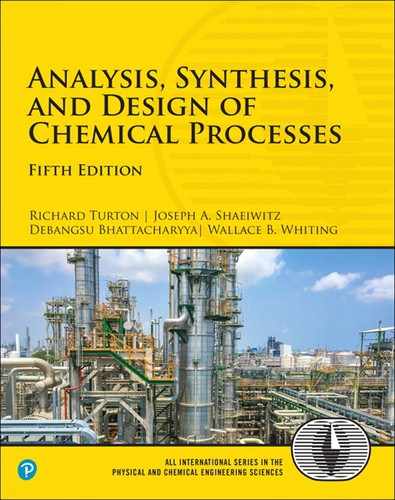Section IV: Chemical Equipment Design and Performance Process Equipment Design and Performance
The previous three sections focused on problems associated with the design, synthesis, and economics of a new chemical process, with less emphasis on equipment design. This section involves the design of new equipment and the performance of existing equipment in a chemical process. Three important factors must be understood:
In equipment design, the input and desired output are known, and the piece of equipment is designed to ensure that the output can be obtained from the input.
In equipment performance, the input and equipment specifications are known, and the output is calculated. Therefore, changes are limited by the performance of the existing equipment.
Any changes in operation of the process cannot be considered in isolation. The impact on the total process must always be considered.
Over the 10 to 30 years or more a plant is expected to operate, process operations may vary. A plant seldom operates at the original process conditions provided on the design PFD. This is due to the following:
Design/Construction: Installed equipment is often oversized. This reduces risks resulting from inaccuracies in design correlations, uncertainties in material properties, and so on.
External Effects: Feed materials, product specifications and flowrates, environmental regulations, and costs of raw materials and utilities all are likely to change during the life of the process.
Replacement of Equipment: New and improved equipment (or catalysts) may replace existing units in the plant.
Changes in Equipment Performance: In general, equipment effectiveness degrades with age. For example, heat transfer surfaces foul, packed towers develop channels, catalysts lose activity, and bearings on pumps and compressors become worn. Plants are shut down periodically for maintenance to restore equipment performance.
To remain competitive, it is necessary to be able to alter process operations in response to changing conditions. Therefore, it is necessary to understand how equipment performs over its complete operating range to quantify the effects of changing process conditions on process performance.
The material provided in this section involves several categories of design and performance problems:
Design Problems: The design of typical chemical process equipment is presented, and the equipment constraints and limitations are discussed.
Predictive Problems: An examination of the changes that take place for a change in process or equipment input and/or a change in equipment effectiveness.
Diagnostic/Troubleshooting Problems: If a change in process output (process disturbance or upset) is observed, the cause (change in process input, change in equipment performance) must be identified.
Debottlenecking Problems: Often, a process change is necessary or desired, such as scale-up (increasing production capacity) or allowance for a change in product or raw material specifications. Identification of the equipment that limits the ability to make the desired change or constrains the change is necessary.
This section introduces the basic principles by which existing equipment and processes are designed, evaluated, operated, controlled, and subjected to changes in operating conditions. This material is treated in the following chapters.
Chapter 19: Process Fluid Mechanics
The basic design of pumps, pipes, etc., is presented for incompressible and compressible flows. The performance of pumps and existing piping systems is also presented.
Chapter 20: Process Heat Transfer
The basic design of heat exchange equipment is presented. The need for multiple shell-pass heat exchangers is discussed based on the LMTD correction factor. An extensive treatment of heat tranfer coefficients for typical process situations, including boiling and condensation, is included. The performance of existing heat transfer equipment is also presented..
Chapter 21: Separation Equipment
The basics of typical chemical engineering separations (distillation, absorption, stripping, extraction) are reviewed, but not with the depth found in standard separation textbooks. The equipment design characteristics are emphasized. The performance of existing separation equipment is also presented.
The basics of reaction engineering are reviewed, but not with the depth found in standard reaction engineering textbooks. “Real” reactor configurations are discussed in depth. The performance of exisitng reactors is also presented.
The design and performance of pressure vessels, knockout drums, and steam ejectors is presented.
Chapter 24: Process Troubleshooting and Debottlenecking
Case studies are presented to introduce the philosophy and methodology for process troubleshooting and debottlenecking.
